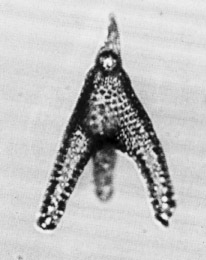 Sethochytris
triconiscus Haeckel
Sethochytris
triconiscus Haeckel Sethochytris
triconiscus Haeckel
Sethochytris
triconiscus Haeckel[?] Sethochytris triconiscus Haeckel, 1887, p.1239, pl.57, fig.13; Riedel and Sanfilippo, 1970, p.528, pl.9, figs.5-6
Cephalis poreless, spherical, bearing a stout conical horn. Thorax pyriform with circular pores, drawn out in its distal part into three divergent cylindrical porous tubes, which are open terminally. In some specimens, a rib terminating in a short free spine can be distinguished in the outer wall of the distal portion of these tubes (Riedel and Sanfilippo, 1970).
Total length of skeleton 150-210 µm, its total breadth 100-170 µm (Riedel and Sanfilippo, 1970).
Total length 140-235 µm; maximum breadth 85-170 µm (Sanfilippo et al., 1985).
This species is distinguished from its ancestor Sethochytris babylonis and from Lithochytris archaea Riedel and Sanfilippo (1970, p.528, pl.9, fig.7) and Lithochytris vespertilio Ehrenberg (1873, p.239) by having porous subcylindrical feet, and from the two last-mentioned also by being smaller and having only two segments. The scope of Sethochytris triconiscus is here modified to the extent of admitting specimens with feet closed terminally (Riedel and Sanfilippo, 1970, pl.9, fig.5), so long as they are long and subcylindrical rather than short and conical (Sanfilippo et al., 1985).
This two-segmented form has its tetrahedral thorax drawn out distally into three long, divergent, subcylindrical (not short, conical) porous tubes, which are open or closed with a spine distally. In some specimens, a rib corresponding to this spine can be distinguished in the outer wall of the tubular feet (Sanfilippo et al., 1985).
Sethochytris triconiscus occurs widely in tropical assemblages of late middle Eocene age. Its morphotypic first appearance lies within the Podocyrtis mitra Zone and its morphotypic last appearance lies within the Podocyrtis goetheana Zone.
Intermediate transitional forms indicate that Sethochytris triconiscus arose from the S. babylonis group. It left no descendants.